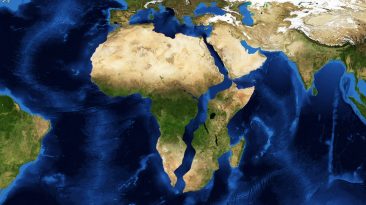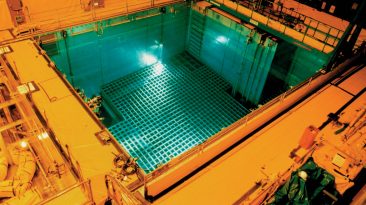The Earth may not be our home forever. Eventually, we may have to leave. What if instead of finding a potentially habitable exoplanet light-years away, we stayed in our Solar System and built a habitat so enormous we could never overpopulate it?
How would we go about building such a thing? Where would we find enough materials to construct this cosmic megastructure? How long would it take before we could move in into our new artificial home?
Imagine you lived on a ring with a radius of 150 million km (93 million mi) encircling the Sun. A gigantic artificial world with its own gravity, ecosystem and atmosphere. A world with three million times the area of the Earth – big enough for trillions of humans to call home.
You’d live on enormous landmass on the inner side of the ring. The outer shell would protect you and all those trillions of people from the hazards of outer space.
How does that sound? Problem is, assembling such a thing – suspended out in the Solar System – wouldn’t be easy.
You couldn’t just pull the Earth apart and have an army of robots reassemble it into a ringworld. Among the many problems you’d run into, your first would be finding the material.
The International Space Station roaming the Earth’s lower orbit right now weighs about 420 tons. Something like a ringworld would tip the scales at no less than a million tons. Where would we find so much material?
I know some places. The Kuiper Belt beyond the orbit of Neptune would do just fine. This ring of icy bodies stretches out for almost 3 billion km (1.9 billion mi).
Some astronomers think the Kuiper Belt would have enough material for this project, although it’s hard to tell exactly how much we’d need to construct a thing like this.
We might have to sacrifice all the planets, moons and asteroids in the Solar System. Our ringworld would be left all alone in the entire Solar System.
If we could manage to gather and transport all the material available, then construction would begin. It would take a lot of physical labor, an army of robots and maybe hundreds of generations to realize that our structure was not stable enough.
Because the megastructure would turn out so enormous, it would break any known molecular bonds. We’d have to find a way to make use of one of the fundamental forces of nature – the strong nuclear force. Of all forces, it’s the grippiest – it bonds material on the scale of atomic nucleus so that nothing can break it apart.
Or maybe we’d come up with a new super-strong material altogether. But until we figure that out, every interstellar body passing through our Solar System would be a threat to our megastructure.
The next thing we’d have to worry about is gravity. That part is pretty easy – we’d just have to spin the ringworld at nearly 2,000,000 km/h (1,200,000 mi/h).
I know, that’s really fast. We’d have to build up the speed over time. Luckily, maintaining it in the frictionless environment of space wouldn’t be too hard. Such rotation would generate centrifugal force, and that, in turn, would create an artificial gravity equal to the one we have here on Earth.
With gravity solved, we’d bring in the atmosphere and start populating the ringworld. For the inhabitants of the megastructure, it would always be daytime.
Unless we could create a day and night cycle with extra panels inside the ring. These panels would not only block the sunlight in some areas to give us nighttime. They’d also be good for harvesting energy from the Sun.
But for all the epicness of the world we just created, it wouldn’t be stable. A single asteroid strike could cause the structure to drift closer to the Sun. A hole punched through the ring could let all our atmosphere out. And a massive solar storm? Don’t even get me started on that one.
One failure inside the ring could doom the entire structure together with its inhabitants. It’s just too risky to build it around the Sun. We might have better luck with a huge ring space station in the Earth’s orbit.
Subscribe to What-If on Youtube or follow the show on Facebook Watch.
Sources
- “Will We Ever… Build Ringworlds?”. Allison, Peter. 2019. bbc.com. Accessed April 19 2019.
- “Could We Build A Ringworld?”. Hadhazy, Adam, 2014. Popular Mechanics. Accessed April 19 2019.
- “How Much Technology For A Ring-World To Work?”. Worldbuilding Stack Exchange. Accessed April 19 2019.



























